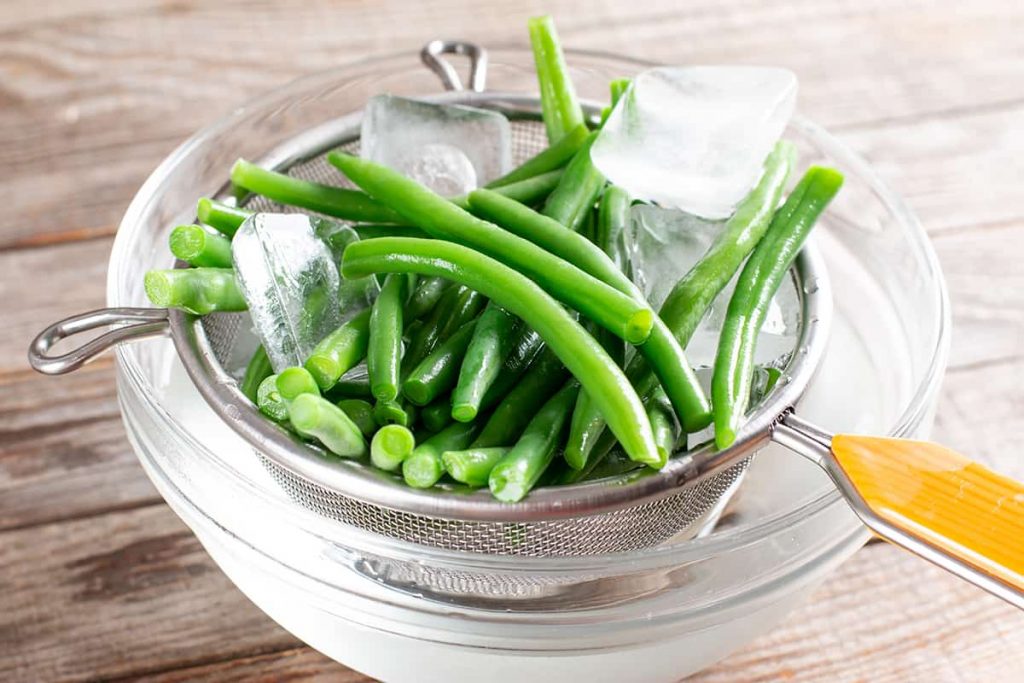Blanching green beans in advance is a great time-saving technique for meal prepping. But can you actually blanch green beans ahead of time? The answer is yes! Blanching green beans in advance allows you to enjoy fresh crisp green beans whenever you need them with no last minute cooking required.
In this detailed guide, we’ll explain everything you need to know to successfully blanch green beans ahead of time. We’ll cover:
- The benefits of blanching green beans in advance
- Step-by-step instructions
- Pro tips for best results
- Storage and reheating blanched beans
- Answers to frequently asked questions
So read on to learn how blanching green beans in advance can make your life easier!
Why Blanch Green Beans Ahead of Time?
Blanching is a cooking technique that involves briefly boiling vegetables then immediately cooling them off. When done properly, blanching green beans ahead of time offers several advantages:
-
Preserves texture – Blanching retains the bean’s signature crunch.
-
Retains color – The bright green color is “locked in” instead of fading.
-
Saves time – No need to cook beans when you’re ready to eat them
-
Adds versatility – Blanch then freeze beans to have them ready anytime.
-
Lengthens shelf life – Blanching stops enzyme actions that cause deterioration.
So blanching green beans in advance gives you tender, crisp, vibrant beans ready to use anytime! Let’s look at how to do it.
Step-by-Step Guide to Blanching Green Beans
Blanching green beans is simple but there are some key steps to follow:
Ingredients:
- 1 lb fresh green beans, washed and trimmed
- Water for boiling
- Ice water bath
Instructions:
-
Bring a large pot of water to a boil. Use at least 6 cups water per 1 lb of beans.
-
Prepare an ice bath by filling a large bowl with ice water.
-
Add the green beans to the boiling water and cook for 2-4 minutes. Time will vary based on thickness.
-
Test a bean for tenderness. It should be bright green and just starting to soften.
-
Drain beans and immediately plunge into the ice bath. Let sit 1-2 minutes.
-
Drain beans well and pat dry with paper towels.
-
Portion beans for storage in airtight containers or freezer bags.
-
Refrigerate up to 3 days or freeze for longer storage.
That’s really all there is to it! Now let’s look at some pro tips for success.
Expert Tips for Blanching Beans
Follow these tips for perfectly blanched green beans every time:
-
Use very fresh, crisp beans – older, limp beans won’t have the same texture.
-
Undercook slightly – beans will cook more during reheating.
-
Shock in ice bath immediately to stop cooking.
-
Dry beans very well before storage to prevent sogginess.
-
Blanch similar sized beans for even cooking.
-
Work in batches to avoid crowding beans during blanching.
-
Use blanched beans within 3 days for best quality and texture.
-
Add salt after reheating, not before, for best flavor.
It’s important to closely follow proper blanching methods. Now let’s look at how to store and reheat the beans.
Storing and Reheating Blanch Beans
Proper storage and reheating are also important:
To store:
-
Refrigerate in airtight container up to 3 days.
-
Freeze in single layer on tray then transfer to bags.
-
Press out excess air and seal containers/bags tightly.
To reheat:
-
Steam, sauté, or microwave just until heated through.
-
Don’t overcook or beans will become mushy.
-
Season with herbs, olive oil, salt, and pepper after reheating.
Avoid:
-
storing blanched beans too long before use
-
washing or rinsing beans before reheating
-
cooking beans again at high heat or too long
Follow these guidelines to enjoy tender, crisp, perfectly blanched beans anytime!
Frequently Asked Questions
Still have questions? Here are answers to some common queries:
How long do blanched green beans last in the fridge?
Blanched beans will retain best quality for 2-3 days refrigerated. Cook within that time frame for optimal freshness and texture.
Can you freeze blanched green beans?
Yes! Blanch, dry, and freeze beans in a single layer on a tray before transferring to bags. Frozen, they will last 10-12 months.
Can you blanch green beans without ice water?
It’s possible but not recommended. The ice water bath stops the cooking process quickly so beans stay crunchy. Without it, they’ll overcook.
Should you rinse blanched beans before using?
No, rinsing isn’t necessary and may wash away some nutrients. Simply pat dry and use as is.
Can I season blanched beans before storing?
It’s best to season just before use. Salt and other seasonings can turn beans soggy during storage.
How do I reheat frozen blanched beans?
Steam, sauté, or microwave frozen beans briefly, just until heated through. Avoid overcooking or they’ll become mushy.
Put Blanching to Use!
Now that you know how to blanch green beans in advance, you can enjoy tender, crisp beans whenever you want them! Blanch a batch on your next day off then use them all week long in salads, sides, meal prep bowls and more.
Blanching truly makes preparing green beans quick and easy. With this simple technique, you can have perfect green beans ready in minutes, not just when you have time to cook them. Give it a try and see how blanching green beans ahead of time can simplify your meal planning.

how to blanch (par boil) green beans
- Bring a pot of salted water to a strong boil
- To clean the green beans, cut off about a quarter-inch of the ends.
- For about two minutes, boil the green beans in water. It should be about 80% cooked. You don’t want it to be fully cooked or tender.
- First, take the green beans out of the boiling water. Next, put them in a bowl of ice water to stop them from cooking.
- The cold water will stop the food from cooking and help the bright green color stay put.
- Put the green beans in the fridge until you’re ready to use them. Wrap them in a damp paper towel.
- It only takes a fraction of the time it would take to cook something from raw when you take them out. You can sauté, boil, steam, microwave, grill, or do just about anything else.
Why Blanch (par boil) Green Beans
While there are many reasons to blanch green beans, really it comes down to two things for me.
- Time management can really help in the last 10 minutes before dinner is served.
- Better cooked beans—no more ugly, bland, or overcooked ones
Adding blanching to the cooking process may make it take longer, but it can really help you keep track of time. The blanching step does add about 10 minutes to the process, but you can do it hours (or even days) ahead of time. If you want to serve the green beans right away, you can heat them up for about two minutes. This is where the time savings really pay off. While I’m trying to finish cooking the chicken, fish, pork, or whatever I’m making, pour drinks for everyone, and set the table, I’d gladly have the green beans taken off my plate. They are already 90% cooked, and sitting in the fridge. It doesn’t take me long to get them out, heat them up, and serve them—just five minutes before the plates come out. Blanched geen beans are better green beans.
The other reason why you should blanch greens beans, is you simply end up with a better bean. When you blanch properly, the bright vibrant color of the bean keeps all the way to dinner plate. Do not blanch the beans before cooking them. If you don’t, they will turn a dull, drab, blah, grey-ish (some might even say puke-ish, but I won’t because I have a good blog here) green that looks like it just came out of a can packed in the 1950s. When you blanch green beans, you’re much less likely to over- or under-cook them, and they keep their color. Since you’re probably blanching them ahead of time, you’ll be paying more attention to cooking them. When blanching, it’s pretty easy to get them just right—firm, not mushy. Shocking them in cold water stops the cooking process. When it’s time to serve, it’s easy and quick to reheat them, so they won’t get too done. Blanching them is about as foolproof as it gets.
Of course, blanching doesn’t stop at Green Beans. You can blanch a ton of vegetables, and the benefits are really amazing. Check out my blanching page, and be prepared to be wowed!.

